#all colors are good it just depends on visual context
Explore tagged Tumblr posts
Text
unfortunately beige can be a really nice color actually but rich people are so fucking bad at it
#all colors are good it just depends on visual context#anyone who's like 'ugh i hate yellow' okay you hate the shining golden yolk of a runny egg? you hate dandelions in the spring??#anyway. my preference for earthy tones has expanded to include what people call 'neutrals' i.e. a lot of white and brown shades#this is not apologism for the rich people minimalism/neutrals hellscape theyre soo bad#kardashian all white house or whatever special circle of hell. die. but white itself can be nice color we dont need to renounce it entirely
90 notes
·
View notes
Note
https://twitter.com/taemacious/status/1824164920503754759?t=dB_2q5Aoy398OJdjFEnQ7g&s=19
Why can't these people just enjoy anything? Always trying to create fanwars over nothing.
Jimin wore that shirt in 2022 for his photobook, Taemin is wearing now. Where is Jimin copying Taemin? Or even of each were "copying" the other so what? They've said they each inspire the other and they are good friends. Can't enjoy anything on kpop, it's always fighting and fighting.
I find so called connections based on out of context visual similarities not only a complete waste of time, but also a null point of interpretation. Or what is actually an attempt at interpretation, but falls short even in that case.
That connection is usually devoid of any attempt at trying to see if there's at least thematic intertextuality, something that would make the interpretation of possible visual similarities a valid argument.
In fandoms and consequently with stan mentality, this is merely a superficial attempt. X wore a similar outfit to Y a few years ago, there's a connection. One set of a music video has similar elements to another one, there's a connection. Same haircut and color, same jeans, similar jacket, similar sweater and so on. This in turn becomes weaponized and used differently, depending on the purpose a fandom/individual fan or stan has.
One would be to show the influence. It's usually used from a hierarchical perspective based on a number of aspects and it's a one-way street, top to bottom judgement and rarely one in which it would show that artistic influence works on different levels.
Then there's the other one, more common in fan spaces and usually used as a method to create conflict. The tweet you sent is part of that. And the original collage as well. It stems from a competition, imaginary or real, that only involves individuals active in fan spaces and not the idols themselves.
Both purposes have their basis in what is essentially a weak argument. More often that not, there is never a real attempt at an actual analysis. If so, then that would mean that someone would take a look at those concepts and analyze them by using at least one theoretical perspective which can be one of the following or more: historical (is that similarity actually a product of its time and what was the trend in k-pop at that specific moment in time), socio-economic, aesthetic, thematic, cultural, etc.
But that is not something that fans active in social media spaces are willing to do and perhaps it would be too much to ask that of them. I would rather want them not to do it at all, but I don't control fandoms.
As a result, these poor attempts that are mostly the result of stan mentality are essentially a waste of time. I didn't want to answer this initially because it's something that I have seen done time and time again and I can't be bothered with it anymore. But anyway, I have now expressed my position and I have said everything I have to say. I won't answer follow up asks on the topic.
12 notes
·
View notes
Note
Lucky my friend Lucky do you have any tips for pixel art? Specifically like, how to pick a good canvas size and just kinda like, what your process looks like? Do you already sketch in pixels, or do you sketch in a bigger size and then translate that into pixel art?
hi ceph!! I'm on my phone rn so I don't have any visual examples of my own process but I can still give you some tips :3
on canvas size: I actually typically work on a fairly big canvas because I like having multiple sprites open at once (like on a sprite sheet), but at the moment since I'm doing isat related stuff (and isat was made in rpgmaker mv) I'm working with 48 pixel tiles. this is kind of an unusual tile size (being between 32 and 64) but it's what the engine works at and I'm reusing a lot of assets for other things. for many games tile size can be either somewhat irrelevant or only for like, environmental stuff, I don't believe undertale/deltarune is constrained to tiles at all for the characters, but considering the maps are still made with a tile system it does still kind of influence how big the characters get.
choosing a size to constrain your pixel to art will kind of be based on what you're trying to convey with it. is this supposed to be an overworld sprite (the sprite you move around in an rpg)? is it an enemy battle sprite? is it a talksprite? i'd recommend looking at the sizes of sprites in games you like and trying to kind of replicate those sizes/proportions, especially when starting out. I also recommend that you work with smaller sizes at least a little bit-- the smaller your canvas the more different pixel art is from illustration. this has positives and negatives but it'll give you tools that you'll use at a larger size.
on sketching/planning: it depends on the size. larger sprites found in contexts like battle sprites (taking up maybe a 5th of the screen of a game?) I definitely do a structural sketch, though I typically ditch transparency and just do it in red and then line over that. smaller sprites I feel like feel more like sculpting-- I'll kind of block out the very basic proportional silhouette if anything before going back and detailing. honestly though a lot of the time you'll only need maybe a height of a character, the size of the head, and then like where the legs begin and end.
bonus tips: look up beginner pixel art tutorials they'll teach you some really fundamental things about like keeping your lines clean. know that a lot of pixel art is finding compromises, a lot of what you'll be doing esp later on is trying to decide what looks better between like, the configuration of maybe three pixels or something. I'll often leave a sprite to sit for a couple days and refine it a bit more. dithering is cool. keep in mind your color count. and don't forget to have fun 👍
4 notes
·
View notes
Text
Welcome To Demon School! Iruma-Kun Volume 1: The Misfits
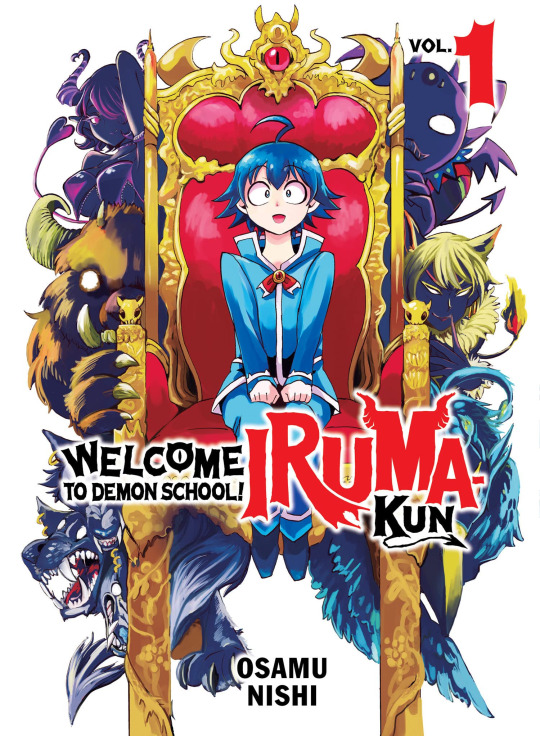
It's been several years at this point since I stumbled across Iruma-Kun as an anime. Three seasons deep with all sorts of content and arcs, and a mountain of manga chapters and volumes I never thought I'd get in English. But it's here. Somehow, it's made it here and I'm endlessly excited about that. How does it measure up to the anime? How does the source material differ? What's the art style like? Is there any dropped content? How does the pacing compare? So, so many questions that I can finally answer.
The short of it though? People should absolutely be picking up this manga. It's friendly and welcoming for all ages without feeling too childish or mature, Kodansha's giving it a nice and quick release schedule, it's got 3 Seasons of anime to watch to see if you'll like it, and there's plenty of spinoffs that have a chance to make it over here if this release does well!
⚠️Warning: Spoilers Ahead⚠️
I think the most noticeable difference is in the art. To summarize it, Nishi's style in the manga is rather different to the anime. It's what you might call malleable. The proportions, lighting, even aspects of the core character design ebb and flow depending on the scene they're in. Line thickness and texture moves around, shading and color differs from character to character, and even chibi designs have wiggle room in how they're shown.
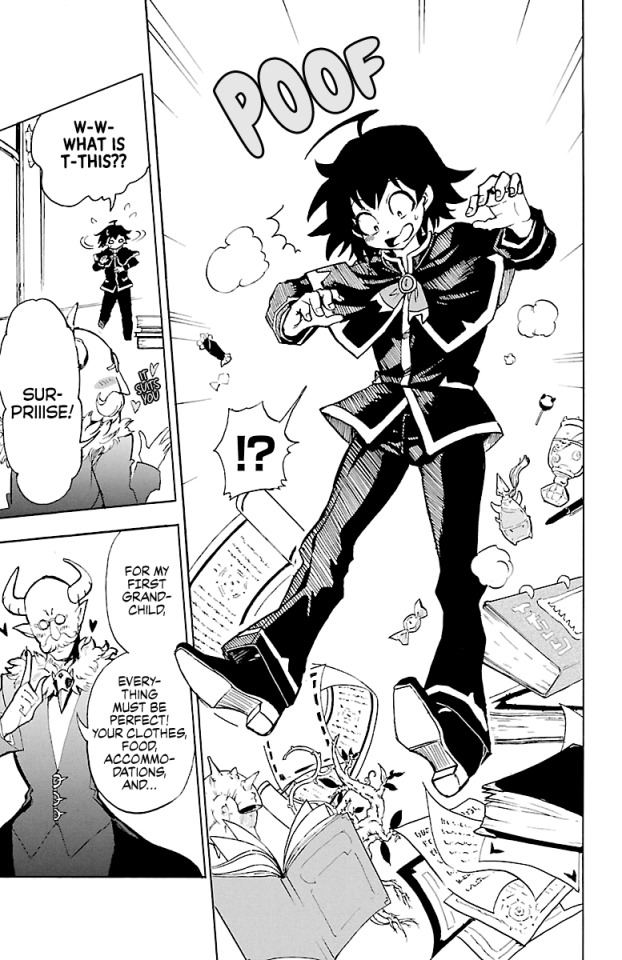
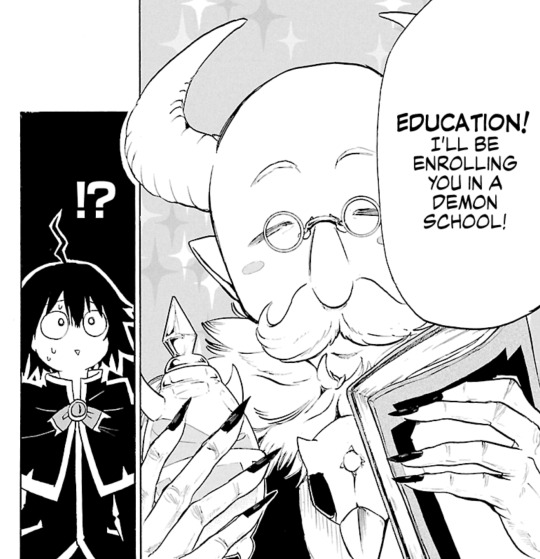
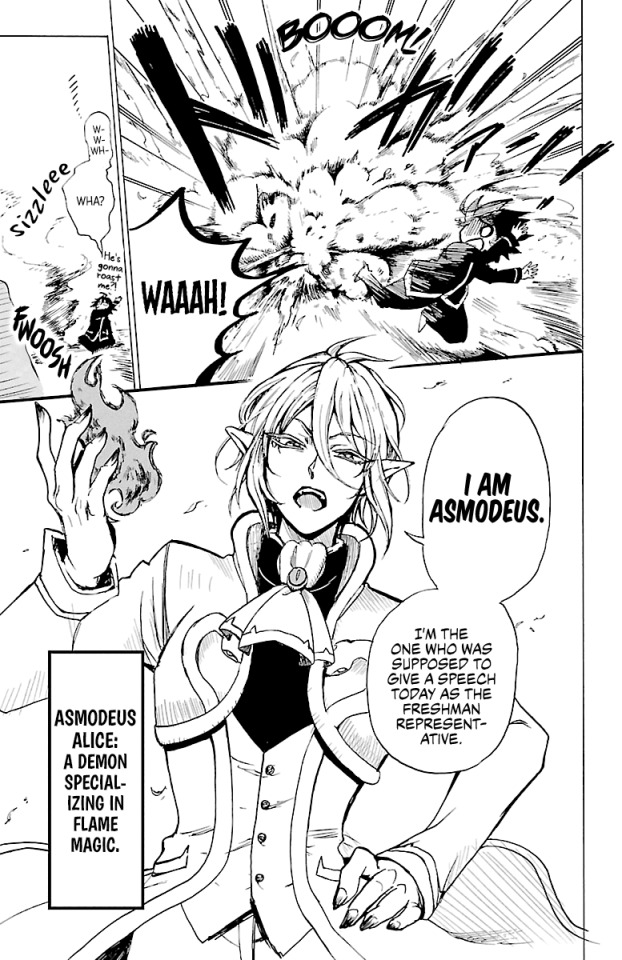
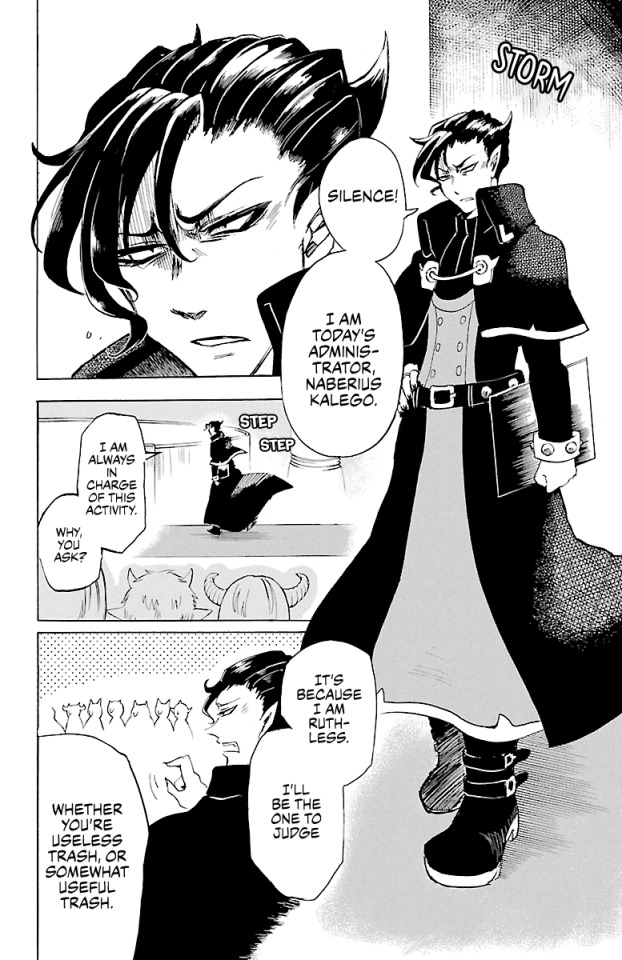
It's really interesting, because through these 4 panels, there's not really a stellar amount of visual similarity in how things are drawn. The shading on Iruma's (top left) clothes vs Kalego's (bottom right) is different, and Kalego's hair has shading and texture while Iruma's doesn't. Azz-Kun (bottom left) has heavy line weight while Sullivan (top right) is a far lighter line weight. It's incredibly curious, because I wouldn't say any of these pages bear much resemblance to one another in how they're drawn, but they're undeniably all from the same artist. It's a really great feat to provide so much consistent variance in art style for the series.
Alongside that, I must say I'm impressed with the paneling as well. You can get a really solid grasp of it from Iruma and Azz-Kun's pages above. There's a lot of variance and different approaches to similar content.
There's different perspectives, angles, and everything keep it all fresh and interesting, and the shapes of the panels are really commendable. It constantly refuses to use clear cut rectangles and squares, and tries its damnedest to put a creative spin on it. Even in pages like this one, all of the panels have an irregular side. At least one line in the rectangle is angled or cut off. It's such a simple thing, but it makes it such a more interesting read as you're not constantly looking at a bunch of plain squares.
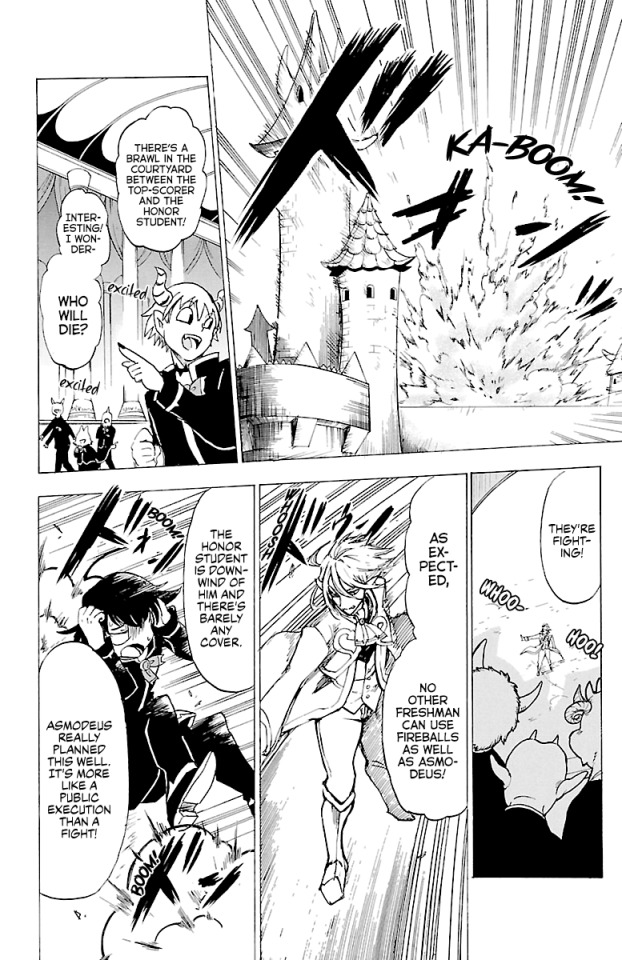
Though, I guess I should take a break from the visual stuff, and talk about story, yeah?
I'm pretty surprised, there's a lot of great moments from the anime that were extrapolated from very minimal context or interaction, and even some that don't appear in the manga. Inconsequential pieces in terms of story, but really great work to expand on the nature and feel of the manga.
Saying that though, there's just as many moments that go shot for shot between the two, like Iruma and Azz-Kun's fight.
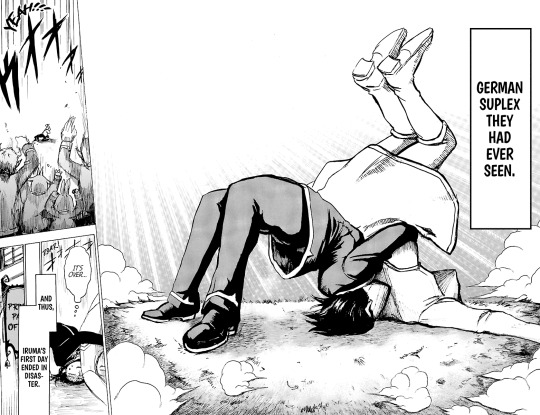
Or Iruma's entrance into the Misfit's classroom.

In addition to that, it's really cool to see how well planned this story is. Being a manga you get to soak up those pieces a lot better, and notice background details and things like that. Just take a look at this panel. Yes, Clara's in it, but there's somebody on the left side as well. Jazz makes an appearance here, and for good reason! Such a fun little detail, and just one example of many that exist within the manga that either didn't make it to the anime, or that I didn't notice in the anime.

Now, the elephant in the room: Lied. His early design is certainly something. I wouldn't say I hate it, but I also wouldn't deny that I vastly prefer his newer/current design a hundred times over. Basically the only design that sees noticeable change through the story, and for good reason. Also, Kerori in the background.

Also, I really just have to give it up for Nishi's art. You get a taste of it in the anime, but it feels so much stronger throughout this first volume of the manga. They like their perspective pieces, and they really like playing with heaver line weight to create tension and energy, and I'm all for it. It's a really fluid experience overall, and is great at selling readers on a more dynamic feel to the art and characters.
Pieces like this where the lines of the panels begin to warp and change, just such cool details that really show how pervasive Nishi's style is to the overall work, how when the style shifts, the whole perception of the sequence does.
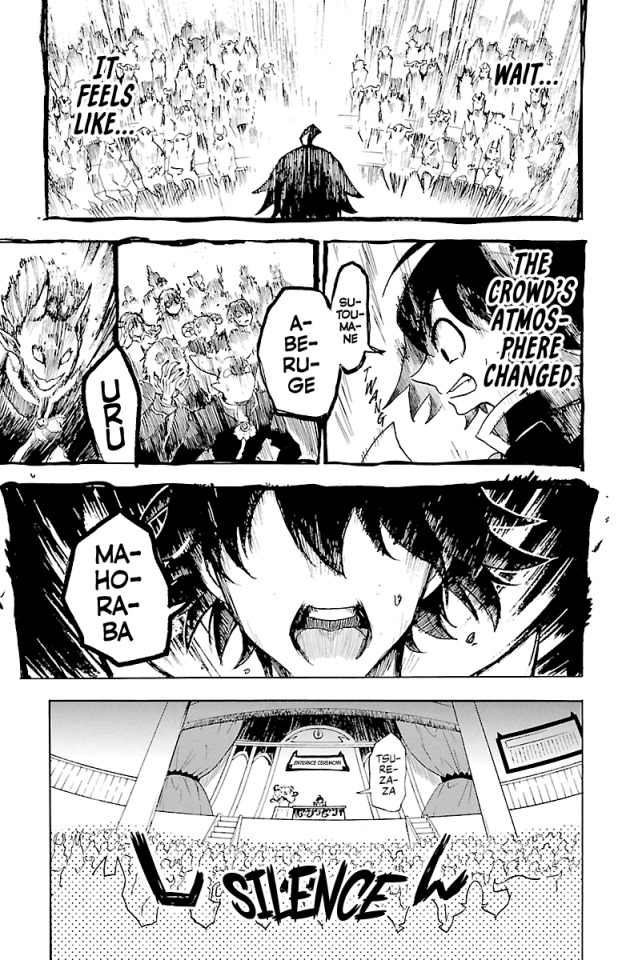
I also feel like this spread is a really great example of why I like Nishi's character designs. They're all incredibly unique, and share very little to tie them to one another. All different outfits, proportions, and features. Clara's got a completely different style to Iruma, who's got a completely different style to Azz-Kun. It's a world of characters in a single story, and really never gets old.

And lastly, here's one of those perspective pieces I was talking about earlier. Nishi doesn't blindly use it to make for cool and more 3 dimensional panels or pages, but to convey something. A stretched out panel of Iruma fretting over being a human at a demon school, or in this case, a skewed perspective to sell the scale and grandeur of the Demon King. We're only at his feet, out of the entirety of his presence, Nishi is showing us where we're at in the story currently. It's a really great idea that just blends implicitly with "big Demon King is cool as hell".
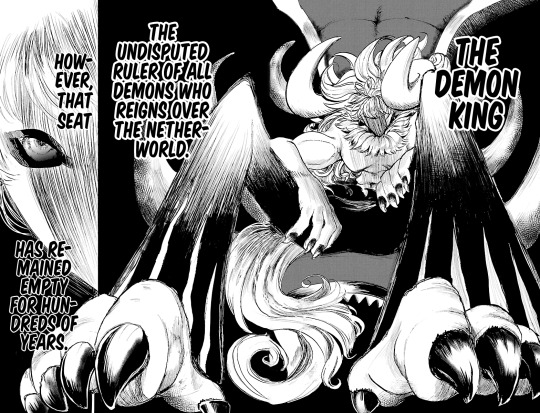
So, at the end of this first volume, I'm thoroughly impressed with both the anime and the manga. The anime really grasps the material well and finds a way to heighten a lot of it, while the manga loses very little expression despite its relative handicap to the anime. Both are undeniably great, and both are certainly worth experiencing.
The energy remains apparent, the story is untouched and in its purest form, the art is all over the place in the best way, and the feel of Iruma-Kun is still so wonderfully strong. The silly nature that will have you breaking out in a laugh at the smallest things remains, and that warm feeling you get from the cuter moments is still there. It's still the same Iruma-Kun I know and love from the anime, and still places at the top of shounen manga that everybody should give a chance.
#mairimashita! iruma kun#welcome to demon school iruma kun#iruma kun#iruma suzuki#魔入りました!入間くん#mairuma#asmodeus alice#clara valac#sabnock sabro#naberius kalego#anime and manga#manga#manga review#manga recommendation#shounen manga#shonen manga
79 notes
·
View notes
Text
When I go to answer a serious ask, I usually type out my initial ideas, save it to drafts, and craft a response after I've had time to think. But recently, some of the asks have just disappeared. Unfortunately, this was one of those instances. (I'm recalling to the best of my ability).
Anon said they felt like the only one noticing how Maneskin use people as props in their photos, usually People of Color.
This topic touches on some of the most historically and currently relevant subsects of society. Race & ethnicity. Social development & communication, (now in the age of social media). Entertainment & representation. Plus, others I'm not thinking of. I want to acknowledge how deserving of an in depth discussion this topic is, while also acknowledging that I'm not informed enough to broach it. So this is gonna be pretty surface, anon, and I'm sorry for that.
What does it even mean to use somebody as a prop?
Props are used to add detail and context which make the subject or background more interesting. As inanimate objects, they only exist to enhance the scene. Therefore, to treat someone like a prop is to prioritize the way they can improve your image over that person's autonomy. Sure, both the prop and subject can both have individuality, as long as one serves to make the other look interesting.
So who's culpable? The subject, the photographer/videographer, perhaps a director of sorts? Personally, I think the blame is shared and situationally dependent.
Below are the most obvious examples of Maneskin using a person as a prop, posted to their insta pages. The trend anon pointed out is evident. Admittedly, I don't have a good sample size here, though. A ton of Maneskin's content is only available on their stories. Especially content with non-band members (which is what anon is referencing), since Maneskin's publicist prefers to post just the band.
I wonder how many of the people in these photos gave informed consent. (Not necessarily to a band member, just someone). As in "This photo will be posted without your name and seen by millions, but you won't receive royalties." Because some of these images Maneskin (the brand) can profit from via merchandise and copyrights. Conversely, most of the folks in the photos will experience poverty in their lifetime. Some of Maneskin's outfits are worth more than the other person makes in a year and they're treating them like a plant. There's also the safety concern. If any of these people have someone in the whole world that wishes them harm, that person can now find their job/neighborhood.
I know these photos aren't all bad. Victoria probably got consent to post pic #5, just a harmless prank. The woman in pic #3 was likely thrilled to be sitting next to such a handsome young man and thinks all social media is Facebook (which she hates). But why take pictures with the Black men in photos #2 & #4? What about the Latinas in #1 & #12? They're are using POCs as visually compelling markers of cultural and ethnic differences to say something meaningful about themselves. Look how far I've come! Look how successful my music is! You envy me, right?




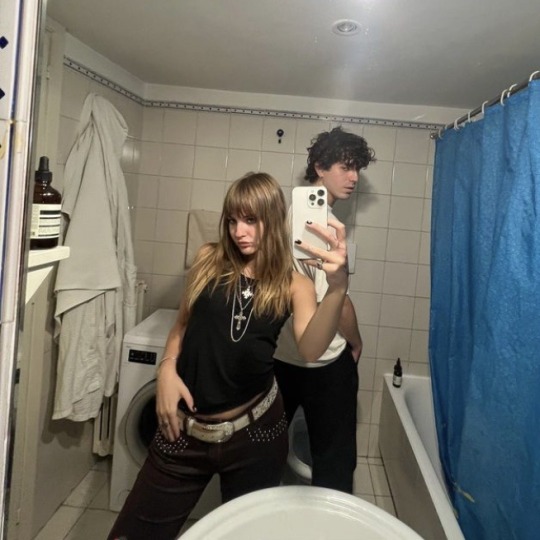


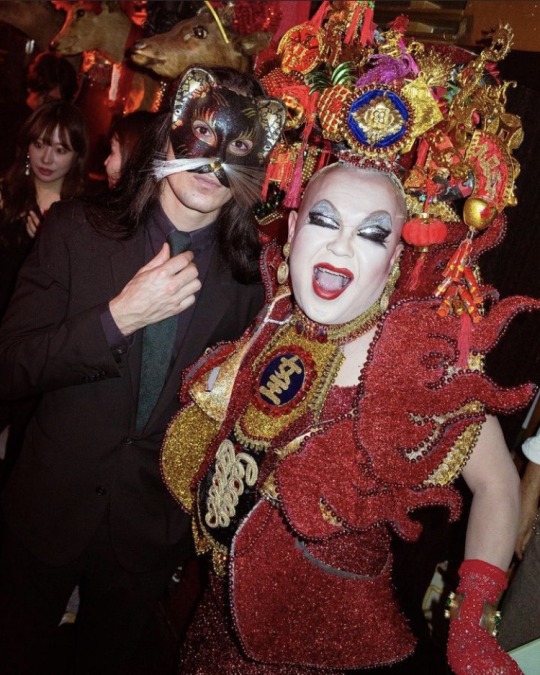


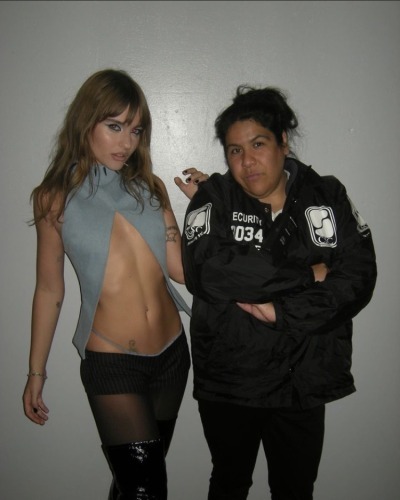

#if this take is too nuanced for you ✨move along✨#yes ANON maybe it wasn't their idea/*insert plausible deniability here*#maybe Maneskin are faultless & culpable for nothing & never make mistakes & above all critique & you will shun me forever OH NO#and they'll eventually ascend to heaven while angels sing Supermodel in a white column of light parting the clouds plus a double rainbow#as max Martin performs fellatio on Vic's strap and a thousand virgins part their legs above as a thousand MILFs part their legs below#THE GREAT SCISSORING. but barring that they are fallible and I'm opinionated so plz exit at the block button. you'll find friends there.
12 notes
·
View notes
Text
#4 - Pac-Man (Coleco Tabletop) (1981)

Now now, sweetie. We have Pac-Man at home.
Remember last week, when we said we were playing something that was officially sanctioned by Namco? Weeeell... We never said it was developed by Namco, just licensed.
Oh yeah, if Galaxian Hardware was us dipping our toes into the world of odd hardware, this is us full-on taking the plunge into the depths of the weird, obscure stuff we have to play. Behold, ladies and germs, the first official home port of Pac-Man! ...Technically, anyways.
For a tiny bit of background context, the Coleco Tabletops were Coleco's own foray into the handheld gaming market. Yes, handheld, albeit maybe only on technicality. These things were no larger than something you could rest on your desk, though you could perhaps hold them directly if you really had the dexterity for it; they were approximately the size of a lunchbox, though, so uh, good luck! Oh, and these were shaped like tabletop arcade cabinets. Coleco had the pedigree to handle electronic games by this point--after all, they made the ColecoVision console just a year after this, so we sure hope they would--so this isn't too shocking to see them here.
As for hardware... Look, we're not gonna sugarcoat it--these are Game & Watch-esque, Tiger Electronics-esque "sheet that lights up certain segments depending on the gameplay" graphics. This is why we had to expressly define what "video elements" meant, because if we didn't, we'd have to decide for ourselves whether to either include or exclude these sorts of games. Ultimately, we decided there was no harm in including these even if there aren't exactly any liquid crystal display elements to the display.
Now, you may be asking--how the heck do we plan to play this thing. This is a full on physical unit, and these things are like, 60-to-100 US bucks secondhand nowadays. And sure, this thing is definitely fair game for emulation, but how would you go about emulating this sort of device?
The answer's a little easier than you might've been expecting.

Thanks, Internet Archive! They have been and are continuing to be invaluable for this project. Case-in-point, they have several pre-configured setups powered by MAME right for you to use in-browser. Handy!
Let's zoom in a bit, and start the main game up.

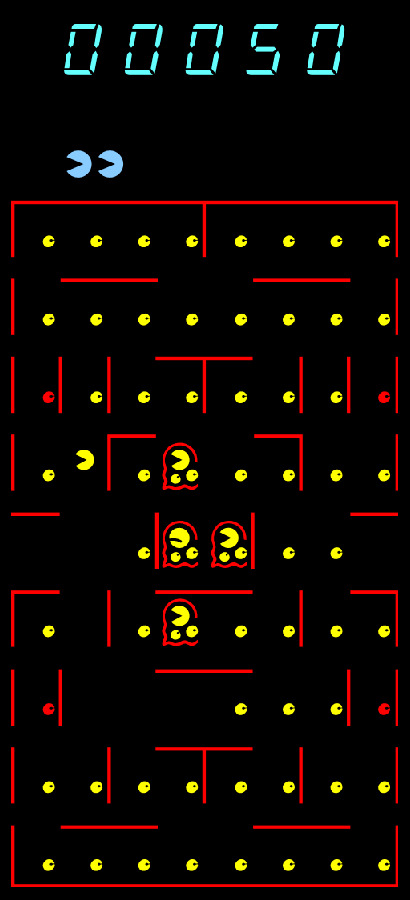
...Gross. And we're not talking about the visuals, but... Maybe we are, because look at those ghosts! While the original Pac-Man hinted that the ghosts may have secretly been slug monsters, here they look more like... amoebas. It doesn't help that one of their eyes is just identical to the slice they're using for pellets, and inside their foreheads is... Pac-Man??? These look a lot like they're gelatinous blob monsters that already ate a Pac-Man! This is NOT how we expected the first game to display multiple concurrent Pac-Men (Pac-Mans?) would go.
As you can imagine from a game that looks this rudimentary, its sounds and gameplay are also pretty bare-bones. Pac-Man, the Ghosts, everything moves with strict adherence to the grid, as you can expect from a Game & Watch-style game. The maze has been simplified--so much so one of the ghosts has been kicked out of the pen and starts the game outside of it! Yet there's also dots immediately surrounding the ghost pen, and with that, zero spot for a Bonus Fruit whatsoever (We'd guess there was just no way to put it on the display, to be fair...)--fundamentally, this game does not, in fact, score like the Arcade version. Which we wouldn't remark upon if the manual didn't brazenly declare it scores like the arcade version. (More on the manual in a bit.) And yet they still somehow got Pac-Man starting by moving left perfectly intact? How baffling, but we're not complaining.
And, perhaps most importantly, the ghosts/amoebas lack unique colors... And indeed, unique behaviors of any kind. The colors are understandable, but the AI is definitely a major downgrade. Now they all act more-or-less the same, and seem to behave a bit like a reverse Clyde, wandering around aimlessly but trying their best to get to Pac-Man when he's nearby.
Probably the biggest change is the fact that these ghosts/amoebas can turn around 180 degrees. In Pac-Man, the ghosts will never reverse directions unless the player eats a Power Pellet--otherwise, they will only make 90 degree turns. Here, however? They will gladly turn around entirely and you have to be careful to avoid that. Being able to turn around freely when the ghosts couldn't was a huge advantage that the player had, but now it's gone! This definitely makes things more frustrating, and while this behavior is often associated with unofficial clones of the game, if you can believe it, this won't be the last time we see this in an official version of the game.


For whatever reason, when you eat a Power Pellet--er, a red pellet, seeing as there's only one type of pellet, just two colors for it--the Pac-Man inside the ghosts vanish? This is what actually clued us in those little dots were meant to be eyes, but then that raises a whole new conundrum... The pellets have pupils now.
Admittedly, this is kind of a Morton's Fork situation that naturally comes from trying to represent every game state in a little drawing like this--either one of the ghosts' eyes would not have a pupil, or now the dots have pupils--but honestly, we feel like maybe the former would've been better, because the latter just kinda looks plain creepy!
In any case, that's the end of the main game, but if you paid attention to the header, you'd know we have two entire other game modes to cover! Yep, this was technically the first Pac-Man game with side content to it.

The second mode, described as Head-to-Head Pac-Man, is... Weird. Another first for the series is concurrent multiplayer! Yep, it debuted here, and we guess a second player mode that happens simultaneously was seen as so impressive that they just had to call it a whole new mode. Fittingly, the handheld has a second joystick just for this.
But... y'know, it's not really all that incredible, mostly for no fault of its own, just because Coleco Tabletop Pac-Man just isn't exactly powerful to do this concept justice. Still, very strange to see simultaneous co-op Pac-Man on this dinky thing from 1981!
The third game mode, Eat & Run, is perhaps a little more interesting, though...


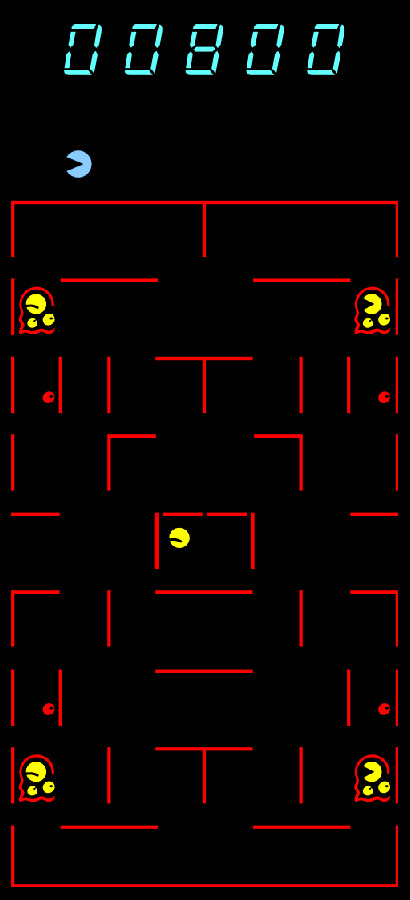
So, a lot of firsts here. Pac-Man has entered the ghost pen--er, the "base" if the manual is to be trusted--for the first time! Not only that, he starts in the base. And the ghosts are in the four corners with four power pellets, with zero normal pellets in sight! This is definitely weird to see so early on in the series, alright.
So, in this mode, you effectively have to play Capture the Flag. The ghosts are already out, and they're guarding the four power pellets--your flags, so to speak. Leave the base when it's open, grab as many of the pellets as you can, but victory doesn't happen when you eat all four. No, victory is only called depending on if you make it back to the base, and the more pellets you have, the more points you get! This means it's actually possible to die with zero pellets left in the maze.
And, of course, the base isn't always open--sometimes, its doors will open and shut, so you have to make it over where while it's open, unless you want to try surviving a cycle until it re-opens. This is a pretty interesting take on the game, and to be honest... It's probably as complex as this thing can handle. We kinda wish we saw a version of this with proper ghost AI and a proper maze (and if that's coming up, don't spoil us.), because it's a fun concept! It's just bogged down by this game and its... eccentricities.
...Oh, right, let's talk about the manual. We never had a better time to elaborate on this, but uhh... It's more than a little flowery, which is a double edged sword. The upside is that it's extremely funny for it! The downside is that it takes a bit of trial-and-error to learn how to work this thing on the Internet Archive's embedded emulator, because instead of clarifying how to start a game, it...
Okay, um. Let's just. Show you a collage of some of the headers in this manual. You'll see what we mean when we say it's extremely funny unintentionally, but also unhelpful when you're trying to find something about, say, how to play the game.
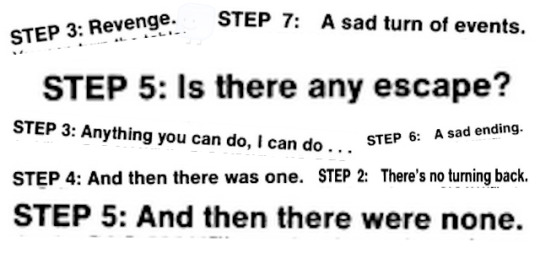
Goodness. Overdramatic, much?! It's just a Game & Watch-esque downscaling of Pac-Man! It's really not that heartfelt, adrenaline-filled, and sobering! Just tell me the button to press to start Eat & Run mode! ...Though, this could serve as a great fodder for blackout poetry, if anything, and as you can see above, it definitely makes for great snippets.
...Well, that's about it for the Coleco Tabletop Pac-Man. But we're not quite out of the woods just yet. So, um, next time around, expect something... Well, a little similar to this, but also a bit different. It's published by Bally Midway themselves, too! ...Technically, anyways. Look, it's complicated. We'll just be seein' you around.
#all the pacs#pacman#pac man#coleco tabletop#1981#man if halloween wasn't last week we'd totally consider those amoeba ghost things to be a fitting halloween thing#unfortunately that's not what we got. or maybe extremely fortunately depending on how you view things!
10 notes
·
View notes
Text
15 Questions for "15" Friends
Tagged by @greypetrel - thank you! :*
Are you named after anyone?
50%-50%? My parents swear that they weren't influenced by Greta Garbo in any way or form - they just liked the name. Stella is for my great-grandmother (hungarian origins, archetype of the "strong woman of the family definitely born in the wrong era").
When was the last time you cried?
Last week. <- Same, wohoo! But it wasn't a big cathartic cry - kind of a disappointing one, really. Yes, I'm a Pisces, of course I sort the act of crying in different categories.
Do you have kids?
Premise: I don't hate kids, and I feel strongly about the fact that they should be more respected as individuals / human beings with their own agency. That being said, I'd rather torn my uterus apart with my bare hands. Or gift it to somebody who wants it. So no: I never wanted any.
What sports do you play/have you played?
Various - tennis for a few years, soccer at school, some athletics. But my love was (is?) dancing - I did modern jazz and then contemporary dance for about seven years. Currently I'm taking hatha yoga classes, which is quite painful most of the time - but necessary, since I have a full time office job and I'm glued to the chair.
Do you use sarcasm?
Me? Never ;)
What’s the first thing you notice about people?
How they move/occupy the space they are in: if they use a lot their hands while talking, how they laugh, their voice etc. I'm a "I first see the broader context and then the single detail" person. And no, I don't judge.
What’s your eye color?
Green/grey
Scary movies or happy endings comedies?
It depends on the definition of 'scary', I suppose. Since that's ambiguous, I'll go with comedies. The right answer is: period dramas, obviously.
Any talents?
I have a very strong memory (name/surname and voice and things they confessed to me of my classmates from Scuola Media, and that was 15+ years ago), which is both useful and anxiety-inducing. I have a pretty good balance, and with some stretching I think I can still put my foot behind my neck?
Where were you born?
In a hospital ;)
What are your hobbies?
Painting/drawing, swimming, photography, reading, trying to find plants that I won't manage to kill. And listening to music - I'm useless with instruments, tho. BUT I do have an electric guitar that my father gave me and I'd love to try to learn something, as soon as I'm not renting and I have a proper place.
Do you have any pets?
Does a seaweed (yes, a marimo) count as a pet? I grew up with a dog, and he died many years ago. Since then I had no pets. Now that I live on my own (very discreet flatmate aside) I'd like to have a cat, but I think it would be better to have a bigger flat, and just more space in general. I'd hate for them to feel bored and costricted, it doesn't feel fair. Right now I don't plan on getting another dog, for various reasons.
How tall are you?
My ID cards have different ideas: the new one says 168 cm, the old one said 170 cm. We shall never know!
Favorite subject in school?
Art history, history, philosophy, biology, and chemistry applied to fine arts.
Dream job?
AHAHA Anyway! Illustrator or teacher. Ideally both. I'd love to work in a museum too, since I already have some experience in that field. Overall, I guess that I need a mentally stimulating job that makes me feel like I'm doing something meaningful - in a way or another. (This is why I briefly considered looking into art therapy, but knowing myself I'd just feel like a huge fraud). ...and I just noticed that all my dream jobs are based on communication (either through visual arts or...talking?) and relating to other people, which is hilarious considering my whole self.
Tag time! :D Maybe @birdkeeperklink - @pyritefes2 & @mafaldinablabla could be interested? Absolutely no pressure tho, feel free to skip this if it's not your thing!
Byeeee
#sorry people the oversharing is strong when i'm tired#and i always end up doing these in the evening#ops#things i've been tagged on
4 notes
·
View notes
Note
Hello hi! i've been a passive viewer of your worldbuilding project of The Forever Ocean and the stories in it for a while now, and a certain thought has been nagging me that i'm curious about All throughout the information you've shared about The Forever Ocean (whether that be worldbuilding related images, characters, or even the organization of stuff on your Toyhouse), i see that the GBVR colours are almost always floating around (from the Kraizen Culture to the Brandshock to some characters having either one of the colours be a heavy part of their colour palette as different hues (especially the main protags of about half of the main parts), and probably many more). which has me wondering a couple things: 1) Why did you decide on green, blue, violet, and red being present so often within the world? 2) Was there a point in time where you were experimenting with what colours you wanted to use for such importance before you settled on this combo?
(Copying from Toyhouse just to make the answer more public)
Green, Blue, Violet, and Red are actually a set of colors I've carried with me since before I can really remember! I'd always see this pattern in the strangest of places in both games, shows, and irl, and it always made me feel something, as if these four colors carried some strange psychological connective meaning when together.
Typically, media likes to use red, green, blue, and yellow, but yellow can be a weird color. It's usually heralded above the others, as some sort of "light" or "holy" color that carried an unequal connotation, placing it above the others. Replacing it with purple gives you four equally strong, bold colors that can go in any meaning direction, depending on who you are.
I never really just "picked" the four, either. It was this natural, gradual retroactive meaning to a pattern I'd been using since I was a kid. The only time I ever thought about using another color group to represent aliens was CMYK, but that group still carries connotations with black being the outlier there.
GBVR is also just good colors to invoke feelings of the 80's or 2000's, a sort of pop-art color scheme that makes you think about neons and the hopes of near-future endeavors. They're bold, strong colors, versatile and able to be applied in many different scenarios and contexts, and remain unique from each other without one being "more important" than the others.
They're also good to use for common visual cues! If you see X color, you think Y thing!
6 notes
·
View notes
Text
i have a very specific artstyle idea for Kokichi- hear me out
so Kokichi, i think we all can agree he's the kind of guy who draws characters in a fairly visually simple style, yes? he's a cartoonist, he gives them simple designs and puts all the characterization into odd proportions and shape language. the characters always look fucking wild with their absolutly uncanny proportions and insanely exagerated (but still simple) expressions, and the lineart is always chaotic and sketchy too.
colors wise he does one of two things depending on the nature of the drawing. he either draws in full, bright ass neon colors- or he draws in greyscale with only one overly satruatate color on a specific part of each character.
backgrounds are more.... interesting- well- not really. they're actually quite normal bacgrounds, but within the context of his artstyle it becomes very interesting. he's insanely good at backgrounds as he spends alot of time drawing blueprints for Miu and/or DICE to use, and they're highly detailed and true to life. the only thing making them feel less so is when he draws for fun instead of for blueprints he allows his lineart to be a bit messy and sketched instead of crisp and carefully placed.
his backgrounds, are also usually done in a watercolor type coloring style, with soft muted colors bleeding together. he doesn't always draw backgrounds, but when he does they're fucking beautiful. when he doesn't draw backgrounds it's usually for a silly comic he doesn't want to spend hours on, but even then he slips some of his detailed ass work in there by drawing overly detailed props for the characters to use.
i just love the concept of him having this jarring difference between his characters and the enviroments there in, it's just so much fun. got a weird little guy who's design can only be described as greebely and skrengkley, and it's sitting on a bench and sipping a drink of questionable content in the most gorgeous park scene you've ever layed eyes on.
14 notes
·
View notes
Note
1, 13, 16, 18, 24 for the fic asks!
1. Share a song that makes you think of [fic title]
Gonna go ahead and recommend "Orgasm of Death" by the Growlers as an "Insatiable" song. I've had that on repeat, rotating those weirdos in my head, for the past couple of weeks.
13. How much planning do you do before writing?
Very little! I usually sit down with an idea for a scene or a feeling I want to convey, write that out, and see if I vibe with it. Then the whole begins to take shape from there.
Unfortunately, the more serious planning I do, the harder it sometimes is for me to get a project started (until I find a scene or moment that sparks). I've been putting a lot of thought into the plot of this fem!Strahm AU but hadn't written a word until I considered a little tertiary scene between Hoffman and Larry and my brain went "oh, that's the vibe." And now we've got a stew going.
16. At what point in the process do you come up with titles?
It depends, but generally it happens seconds before I post the thing (and it's usually whatever Coheed and Cambria lyric I've got rolling around in my head). "Insatiable" is an exception in that the concept for the fic was conceived at the exact same moment as its title (while I was in the bath listening to "Killer Queen" by Queen).
"Color all days blue" is another exception in that I wanted to use the title (was going through a Flowers in the Attic mini hyperfixation) but didn't have a fic to go with it. Then I started writing the summer camp au and thought it fit well.
18. What's one of your favorite lines you've written in a fic?
Hmm. It's hard to choose a line in isolation. I'm not sure any of them are particularly sonorous or meaningful out of context. Nabokov I am not!
24. Share a moodboard for (one of) your current WIP(s)
I don't make visual mood boards, but I do make heinous playlists that are literally just for vibes, so I guess I'll part the curtain and share the one for the fem!Strahm AU. Be warned, though, it's not, like, good quality in any respect. Only vibes here ✨
2 notes
·
View notes
Note
Thoughts on the Donkey Kong Country series? Didnt grew up in the SNES platformer days so it's hard for me to get the high place its heldnup on my own
I feel like there are some people who are even from that era that don't like Donkey Kong Country. There's a lot of focus on whether or not the graphics have aged well or not and whether the gameplay was even any good to begin with.
Maybe I'm a bad person to ask, because I still think those SNES games look incredible. I'd hold them up as some of the best uses of pre-rendered CGI sprites. Later games (usually GBA) used pre-rendered sprites as a lazy shortcut, but DKC was doing it as a deliberate graphical advancement, and that kind of "bleeding edge" vibe still helps the game a lot, I think. They were doing something almost totally brand new, and went out of their way to make it look as rich, vibrant and detailed as they could manage.
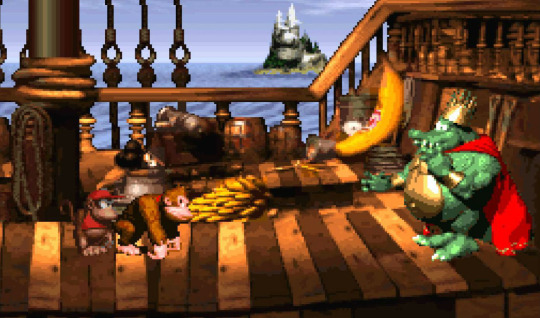
Like, we should put this in perspective. Most 2D games, even now, are made using "tiles" which are square chunks of landscape. For instance, in Super Mario World, all of the levels are made out of 16x16 tiles. That's 16 pixels tall and 16 pixels wide.

In this image, there are only 4-6 tiles being used on the foreground layer, depending on how you count them.
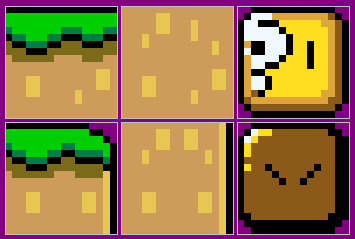
Most levels in Super Mario World probably don't go over a dozen tiles. And this is how it was for a lot of games back then. It was efficient, easily compressed, didn't require too much memory, etc.

By comparison, there are so many tiles in Donkey Kong Country I can't even easily line up where one tile begins or ends. Every level is made up of thousands of individual tiles assembled to create a complex image. And that's just tiles. That's not counting the hundreds of frames of animation in characters, collectibles and enemies, either.
DKC stretches the SNES to every limit it has. It has the most colors, the most animation, the most complex art of basically any SNES game ever made.
Usually, that's where the conversation on Donkey Kong Country ends, because people go "oh well yeah this was impressive tech for 1995 but that doesn't mean anything anymore, it was a flash in the pan and the gameplay doesn't hold up."
I'd argue that it still does. The notable thing about Donkey Kong Country to me, especially in the first game, is how its levels were designed. Levels in DKC are designed with an almost rhythmic kind of flow to them. Every enemy, collectable, platform, and obstacle is usually timed in such a way that you can hit a kind of "perfect sequence" where you tear through entire levels in one unbroken motion.
Or, in short, the entire game is custom-built to be perfect for speed running, years before the concept of "speed running" had ever been coined or popularized. Some games let you do that, but sort of by accident. Donkey Kong Country was designed that way on purpose. It's the intended way to play.
youtube
It's just on you whether or not you can keep up with the game's expectations and maintain that unbroken flow.
That daredevil style of "don't stop for nothing" gameplay style is very appealing to me and even now, close to 30 years later, I still find it a tremendous amount of fun! That first Donkey Kong Country is an all-time great for me.
Later DKC games improve on the visual elements while making the gameplay increasingly more complex to mixed results. DKC2 is a much longer, much more complicated game, and mostly that's a good thing, but it does wear me out a lot faster than DKC1.
And DKC3... has its fans. But I am not one of them.
Does any of this give you proper context? I don't know. It's just why I think the game is neat.
12 notes
·
View notes
Text
Call It Love
Watched: 12.04.2023
Enjoying the angst that comes from misplaced revenge.
Call It Love was emotionally aesthetically pleasing. What I mean is, even the sadness, anger, frustration, regret - all were presented in a way that did not make me feel emotionally exhausted and tired. I was relating to and appreciating the sorrow.
What the show did an amazing job with was showing different sides of psychological issues - for some people it makes them completely detached from social interaction, for some it makes them forget about their needs, others would focus on the negative emotions as their driving force, some would be able to accommodate their lives around their issues. Depending on the character, their personality and past experiences, we saw all the different sides of how we as humans deal with difficult emotions.
About the cast - we got blessed with some well written and complex characters and well delivered portrayals of them. How the same people could be victims and perpetrators. How everyone had to learn from their mistakes and figure out how to set boundaries, but also respect the boundaries others set. How to understand yourself and be able to communicate with others. How to move on from past, how to move forward with the future, how to find happiness and peace.
Were all the characters well written, with many layers? Not quite. While Ahn Hee Yeon did a good job with her performance, Kang Min Young did not exactly have much to offer except from being yet another external factor the leads had to deal with. Similarly, Choi Sun Woo existed only in the context of leads’ issues and struggles, and presented no personal plotlines.
Cast wise, Kim Young Kwang ate the role. One of the most versatile actors we get in mainstream shows. Can do drama, action, comedy, romance, thriller - you name it and you will get it in one of his roles. In Call It Love he presented so many raw emotions from Han Dong Jin. Even though the character was not an open book, not the most expressive guy out there, it was still clear for the viewers what he was going through, what he was thinking and feeling.
At the same time, while for most scenes Lee Sung Kyung did great (it’s a role we have not seen her in yet), there were just a few moments where her delivery was too monotone and at times felt empty.
As for the production - I loved it, but I can see why someone else could hate it. The colors were not saturated enough and the whole show was presented in this pink/purple filter. For me, it perfectly fitted the overall mood of the drama, adding to the melancholic and stoic feeling. What also caught my attention was how the shots were centered vertically. In many the characters were presented in only 1/3rd of the screen. For me it seemed like the same way they were not centered in the frame, they were also not centered in their lives - still unsure about their place, a bit lost in their surroundings.
All that said, it’s a typical “you either vibe with it or not” drama. The same visual aspects I loved could look ugly and weird for others. The same characters I related to and enjoyed analyzing could be frustrating and unrealistic for others. The same dialogues I found touching, others could see as faking profoundness with no depth.
Why not a perfect 10 from me? I did not like some of the conclusions and I wished a few characters were developed better. For such a complex situation the drama presents, some aspects just lacked nuance.
Overall, I already miss this drama.
7 notes
·
View notes
Text
Generally, even badly written alt text is better than no alt text at all - at least then the content is somewhat more accessible.
I've taken a whole course on writing alt text at uni. The infographic above is a pretty good guide. I guess the rule of thumb is: try to identify the purpose and focus of the picture.
You want to describe:
who (or what) is on the picture,
what is the general mood and scenery,
the expression and gestures of depicted people,
and maybe something that catches the eye (it's usually something in relation the the main subject of a picture, like the fruits around the capybara).
You can mention the angle or colors if they're unusual but don't focus on it too much (for a lot of blind people that information is pretty useless. That doesn't mean that you should skip it entirely, though, because some visually impaired people can see colors or light and shadows).
Overall, I'd say to keep it short and simple (at least here, on Tumblr). Long, detailed descriptions are usually unnecessary. However, alt text needs to be context specific, so this depends on the type of the picture. The rule of thumb would be: try to identify what is the focus of the picture and what is the purpose of showing the picture to others (the alt text will be different for pictures in the header of a journalistic article to photos and drawings in a textbook).
So, for example, in case of art, you should depict what you see as accurately as possible, with description of the artstyle, colours, light and shadows (if important for the work), any details (but keep it brief). Try to mention where the characters are in the work and in relation to each other (for example: the screaming character in Munch's "The Scream" is in the centre of the painting, while on the left of the picture in the background two vague figures can be seen). If there are any historical figures or otherwise named characters or other references - name them. Feel free to also mention the medium if it's noticeable or unusual or... shockingly unnoticeable (y'know how sometimes you get surprised by seeing an art piece on Tumblr made with, idk, watercolours when you'd never guess from just looking that that's what the artist's used? Yeah, you can mention that).
Meanwhile, if it's infographics, a chart, or a table, do write down all of the text. With infopgraphics you can mention the shape or color of the font if it's incorporated into the art or somehow related to the content of the picture.
yknow i never noticed the sheer rareness of images having ids or alt text on this website until i started adding alt text to my art (and trying to remember to add it to any images i post in general, especially text screenshots) and that makes me kinda sad
70K notes
·
View notes
Link
0 notes
Text
Modernize Your Marketing with Corporate Brochures
Transform Your Marketing Campaigns with Corporate Brochures
Within a global context defined by constant change, organisations need to be in a position to generate new ideas continuously. One of the most effective yet timeless marketing tools available is the company brochure. A concise corporate brochure can successfully convey to potential customers the qualities, services, and distinctive advantages offered by an organization.It embodies the values of all that the corporation has to offer its consumers, and instills in them who they are as a company, and as a business what they have to offer.
A corporation's brochure is however not just a means of marketing, but also a useful resource that creates a memorable experience. A corporate brochure is one of the most classic and successful marketing tools that may be used. A succinct corporate brochure can effectively communicate to new customers the attributes, products and services, and distinctive advantages of an organization.
The Importance of Corporate Brochures Within Contemporary Marketing Practices
Modern marketing practices depend on corporate brochures. There are numerous benefits,
which include digital marketing alone cannot give, such as:
Ultimate Marketing Tool: A digital advertisement reaches potential clients' screens only. Whereas a brochure is a physical item that potential clients can get, leaf through and even store for use at a later date.
Estabished Business: Brochure maps are designed in a company professionally enhancing business credibility and depicting such a business as established and dependable.
Adequate Detailing: Brochures are useful in giving out information with regard to products as well the services offered and the mission of the company in a proper way.
Corporate Style: A very good tool that can aid in building the corporate style is brochure as some designer and some messages will stay the same.
Critical Components of a Corporate Brochure That Works
In order to get the most out of your corporate brochure, consider including the following critical factors:
Attractive Front Page: The front page is the first aspect that people come in contact with, therefore it should be eye-catching and appropriate. Use striking images and large clear fonts to make people pay attention.
Direct Purpose: The purpose of the brochure should state in few words, the business as the product of company. Do not use any difficult terms and traditions; just find the unique points about your organization and present them.
Respectable Design: Collaborate with a professional booklet designer if you want your brochure to appear neat and refined. Typography, color combinations, and arrangement of elements are some of the important factors to consider about design.
Relevant Material: Satisfy the requirement of the target audience with useful information regarding their expectations and demands. Picture your services, present examples, provide a list of recommendations and contacts.
Call to Action: Advise the readers about the next course of action. Expecting the audience to passively enjoy your article and then calling the company right after cannot work so well and that is why a call to action is very important.
Working Hand in Hand With a Booklet Designer
A booklet designer can be instrumental in changing your corporate booklet from an ordinary information kit to a compelling marketing tool. Here is how they do it.
Aesthetic Consideration: Designers possess knowledge of different visual elements that is meant to help in attracting attention and delivering messages.
Branding: They design the brochure that meets the visual standards of the given brand and is printed geared to all other marketing materials used.
Design: An appropriately designed flyer is friendly in that its readers or users are able to find the relevant information without straining.
Production: They know it is not only the design that counts but also how the materials are produced so that even the worst designer achieves quality results on print.
If you're looking for professional quality corporate brochures, Språk Design is the right place for you. Their seasoned booklet designers can assist you in designing eye-catching brochure.
Revamping Your Marketing Approach With Corporate Brochures
When modernizing your marketing methods utilising corporate brochures, take the following measures into account:
Specify the Objectives
Before using a brochure, it is essential to know the intended result. Are you launching a product that is completely novel, approaching a new geographic market, or boosting brand awareness? Specific goals will direct the design and content process.
Know Your Audience
Audience analysis is critical as it makes it easier to prepare brochures that are pertinent and of interest to the audience. Look at restraints, preferences and requirements of the audience. Aim your message and design towards the target audience.
Emphasis on Quality
Quality is superlative in both content as well as its design. The presence of crisp images, clean text, and well thought out design are an indications of what your audience's view your brand. So hire good photographers and copywriters where needed. 4. Add Some Digital Features
Brochures are targeted as to be purely printed mediums however, the addition of some digital aspects can improve their usage even further. For example, QR codes can direct users to your site, videos or even online catalogs bridging the gap between the printed materials and marketing on the internet.
Measurement and Refinement
Continuously seek opinions and monitor any changes on sales and inquiries after deploying the brochures. Employ the obtained information to enhance superior design and content for the subsequent brochures.
Benefits of Corporate Brochure Designs
There are many benefits of using professional corporate brochures such as:
Improved Trust: A professionally designed brochure is capable of winning the faith and trust of a potential customer.
Wider Audience: Brochures can be handed out in conferences, sent to clients via postage or other ways and put in sales kits thereby increasing your audience.
Pocket Friendly: Brochures are less expensive to make as compared to other marketing approaches in a way that is more beneficial especially for bulk production.
Multifunctional: Brochures are useful in several promotional strategies and can be modified for several reasons such as for launching new products or to introduce a company.
The Last Word
Incorporating corporate brochures in the marketing strategy tends to go a long way in increasing the visibility and the reputation of the brand. Engaging with a professional booklet designer makes it possible to design beautiful brochures while ensuring that the message is put across successfully. This is exactly what Språk Design would help you with since they are experienced in offering creative designs. They know the trends that come up and design their service to provide different and outstanding brochures. For more details on what they can do for you visit the site Språk Design or Contact Us.
View source link : https://medium.com/@robinschley892/modernize-your-marketing-with-corporate-brochures-aec29b1c24f1
0 notes
Text
How to Perfect Shoe Photography in Photoshop
Introduction
Importance of High-Quality Shoe Photography
As the digital retail space becomes a much more visual realm now in e-commerce this opens up other ways. It influences consumer engagement and decisions. People generate impressions from images to try on shoes before purchase. Unfortunately, customers cannot touch or try the shoes on as it would in a physical store. In online shopping however it solely depends on what they observe from their screens. This is why the good shoe photography that you are going to create does not fall into an asset category; instead, it enters as a necessity. A good shoe photo is an emotional sucker. This can draw attention to the design, craftsmanship and material However, bad photos can hurt how people see the product or brand. This can decrease sales and increase return rates.

But shoe photography isn't as simple as taking a picture of some shoes. You are basically SELLING a LIFESTYLE not just moving PRODUCTS. The right image has the ability to emote style, of comfort and a wish. The market is saturated and full of noise. Product photography is your competitive edge. This is especially accurate in Fashion. Everything is always changing, from the behavior of trends and consumer tastes. Having high-quality images also improves the shopping experience as well as trust in a brand.
Overview of Photoshop as a Tool for Enhancing Shoe Photography
Name any photo editing program and it does not come close to being Adobe Photoshop. The best-in-class use of the powerful tools for product image perfection. This is important in the competitive e-commerce industry. With Photoshop, photographers and retailers can manipulate an image in any way they please. This does include some basic stuff … actually, just about everything you can do in Lightroom including exposure and brightness. This covers everything from photo clean up to background removal and shadow creation. This adaptability is needed to give a final polished product now. It will be available for marketing materials, in the online store or on social media.
How to Improve Your Shoe Shooting Outcome Using Adobe Photoshop It can adjust colors, eliminate distractions and draw attention to the product specifics. Move that photo without fear. Photoshop editing non-destructive allows your inspiration flow; you have the original file backup if needed. Test ideas (have you hundreds of images or just one, both could work). Here, creativity has few limitations and always can fall back. This versatile tool allows you to make bold experiments on your entire photo collection. It guarantees a top quality standard of every image. In this blog, we discuss basic Photoshop skills. Here are among the best: they manage to make your shoe shots popping. These will help to improve sales and your branding.
Pre-Editing Preparation
Importance of Proper Lighting and Background
Case in point: the quality of a shoe photo before you open Photoshop. The key to excellent photography is lighting. It forms the quality context of the shoe. The best light you can get with soft, even light is generally going to be natural light. But it can be fickle and might require some pushing around. Soft light shimmers over the shoe, highlighting its detail. Soft boxes cut harsh shadows. It provides detailed precision and continuous light for all details. The goal is a well-lit image. It should show the shoe. Has to be very little editing later.

It places as much weight on the background. Choose a clean, neutral background as white or light gray. This maintains the shoe at point of interest and makes post processing a lot smoother. Put overly-complex, clutter backgrounds can distract from the product itself. This can also make it more difficult to select shoes while editing. A lot of professional photographers will use a lightbox or seamless paper background. It helps to create a dedicated, distraction free environment / home. You want the background of an image, right? It should not fight the shoe for attention.
Camera Settings and Angles
Your camera settings affect your shoe photography results. If you want your images to be sharp, in focus and have great detail between f/8-f/16 is the recommended aperture. That increases the DoF and more of a shoe is in focus. A lower ISO setting, generally somewhere between 100 to 400 will reduce image noise and distortion. Another tip to avoid camera shake is by using a tripod. It is useful especially when some of the subjects require slower shutter speeds.
The camera settings should be just as important to you, and furthermore, the angle is what makes one shot different from another. View Gallery 0 Photos Inside, the cuts are just as clean. Side views show sleek profiles. Close-ups highlight textures. Judging by the top-down shots, lacing is pretty minor as well. Tilted angles exhibit unique compositions. The angularity of every view reveals a different aspect of the shoe's overall shape and functionality.

For brands related to shoe photography you will often make a shooting campaign depicting shoes from the following angles:
The side profile, displaying design.
From the top down showing insole and details.
45-Degree Angle — A Hybrid Of Both
Try different angles. It will assist you in knowing the best view of shoes. This will also make your marketing assets more versatile.
Organizing Your Photos
Photo managementFollowing on the heels of taking pictures is organizing your shots. Look, it is typically the most overlooked crucial step. Effective organization can speed up the process of becoming debt free. It also helps in decreasing the hassle of going through hundreds or thousands of files. Start by importing your images into a photo tool like Adobe Lightroom or Bridge. Check and order images with these versatile tools. Organize your thumbnails in the specific folder angle, lighting or shoe models. Work with a logical content framework to streamline your workflow
Choose the Images with Clear Composition and High Clarity to edit Organize your video in separate folders for each stage of editing. Label them RAW Images, To Edit, and Final Edits. This will allow you to go with the workflow. Then it will be easier for you to track your progress and make necessary amendments. As well as backing up your images to a hard drive or the cloud. This prevents data loss.
Basic Photo Enhancements in Photoshop
Importing Images into Photoshop
Import Your Selected Photos Into Photoshop The first step to your workflow in photoshop is import the photos you have picked out. Open it using the File -> Open menu. Navigate to your images and open the files in Photoshop. Use Adobe Bridge or Lightroom for faster imports with batch processing images. They come with bonus options such as keyword tagging and metadata editing. You will be able to structure an image library of your own.
First things first… Open your image in Photoshop, and then duplicate your original layer. Duplicate Layer by right-clicking on it. The original then gets backed up. It allows you to make changes on a separate layer from the original file. When working on duplicated layers, you are editing non-destructively. You will have the original image saved as a backup so you can restore it if necessary.
Adjusting Exposure and Brightness
Both exposure, and brightness are important in any picture including shoe pics. So the colors and details of your shoe may look distorted if it is too dark or bright in certain sections of the image. The product will become less appealing as a result. To do this, select Image > Adjustments > Exposure in Photoshop. This will cause the Exposure dialogue box to open, allowing you to use a slider to change the exposure. We would move the slider further to the right to brighten an image. To decrease exposure and make the image darker, slide it to the left.
The brightness and contrasts are changed in the shoe to look better. Image > Adjustments > Brightness/Contrast. Iluminazione Here, you may increase brightness to make the image brighter. Slide 'Contrast' to make the highlights and shadows gritty. These adjustments highlight the Features of the shoe and make it look more sharp. Don't overdo it. An image can be easily made to look fake by adjusting the brightness and contrast too much.
Color Correction and White Balance
Correct color is essential in product photography. Important when you are dealing with the sale of products online Unsurprisingly, a shoe that looks to be in the wrong color because of poor lighting would have unhappy customers and ultimately returns. Photoshop — Correcting Color They work towards creating the shoe look as human-like as possible.
Make a Color Balance layer: it will be for white balance tweaking. Go to Layer> New Adjustment Layers and click Color Balance. With this tool you can fine tune the colors in your image The sliders for shadows, midtones and highlights. For instance, if your image is blue add yellow in order to diminish the blues. Now you have a bit more of a neutral balance.
The other important tools in color correction are the Hue/Saturation layer. You have access to this by choosing Layer > New Layer Adjustment Hue/Saturation. You have the ability to control three settings with this tool. Modify hue to change color. Saturation: Change the intensity of colors Tune power to change the lightness of colors To adjust to these issues, for example by ensuring that the color of your shoe looks accurate and uniform in all images.
Advanced Editing Techniques
Removing Backgrounds
White background scenarios in E-commerce photography Defusing Product Listings With The Listing Engine This process to remove the background object From shoe photos you may do in some tools from photoshop. Which is the best depends on how complex an image you have. The Pen Tool is the most accurate way to clip out a shoe from its background. It lets you trace a path around the shoe. Afterward you may just \'Paint\' and then right-click>>Make Selection to convert it into a selection.

Now, pick the shoe and click Delete to get rid of its background. Alternatively, mask it off with a layer mask. For faster, though less accurate results use the Quick Selection Tool or Magic Wand Tool. This is especially useful when the shoe has a different color from what it stands against. Select the shoe and then clean-up its edges by going to Select → Refine Edge. You can be misogynist here.
Conclusion
In this tutorial, I will walk you through some of the main methods to produce amazing shots using Photoshop. They have tips on how to shoot with available light and go one step further into post-processing. These include Background Remove, Color Correct and Create Shadow. These steps are necessary to make your images professional and convince the buyer. Practice makes perfect at the end of photoshop. Thus, make use of practice and learn from your experiences. Anyone from photographer to retailer, practice makes perfect. You'll be able to take better, more beautiful pictures. Try these things in your projects and let us know how it goes, or ask some more specific questions. Check out our other guides for additional Photoshop tips and tricks.
1 note
·
View note